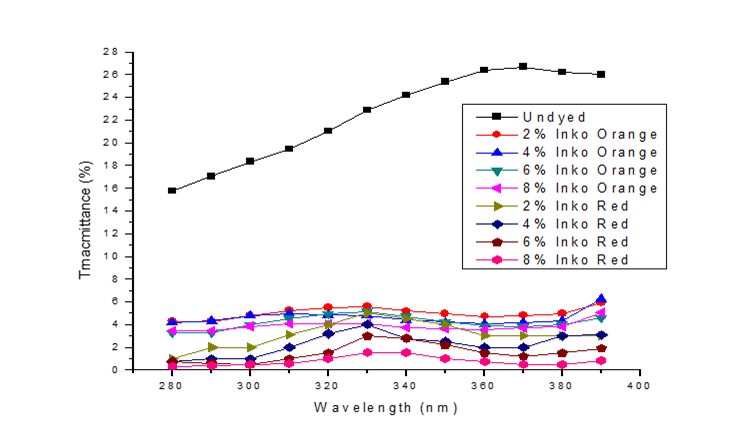Enhancing Ultraviolet Protection of Bamboo Fabrics using Photochromic Vat Dyes
Abstract
 Abstract Views: 0
Abstract Views: 0
Historically, bamboo fabrics have been found to provide inadequate UVR protection, often falling into the poor or no category of Ultraviolet Protection Factor (UPF). To increase the UPF rating of bamboo fabrics, numerous kinds of ultraviolet absorbers have been utilized during the dyeing and finishing processes. Bamboo is a novel type of cellulosic fiber. This research has focused on evaluating the UV protection capabilities of bamboo fabrics, dyed using photochromic vat dyes. It is also important to note that no previous research has examined this topic, specifically the analysis of UV protection of bamboo cloth with photochromic colors. This research examines the UV protection capabilities of bamboo fabrics dyed with photochromic vat dyes. According to the results of the investigation, bamboo fibers can be colored utilizing the continuous dyeing process and light-sensitive/photochromic vat dyes. Furthermore, the findings demonstrate that the UPF values of bamboo fabrics significantly increase with the rise in dye concentration of vat dyes.
Downloads
References
Y. J. Park, G. H. Kwon, J. O. Kim, N. K. Kim, W. S. Ryu, and K. S. Lee, “A retrospective study of changes in skin cancer characteristics over 11 years,” Arch. Craniofac. Surg., vol. 21, no. 2, pp. 87–91, Apr. 2020, doi: https://doi.org/10.7181%2Facfs.2020.00024.
C. Garbe et al., “The evolving field of Dermato-oncology and the role of dermatologists: Position paper of the EADO, EADV and task forces, EDF, IDS, EBDV-UEMS and EORTC cutaneous lymphoma task force,” J. Eur. Acad. Dermatol. Venereol., vol. 34, no. 10, pp. 2183–2197, Aug. 2020, doi: https://doi.org/10.1111/jdv.16849.
T. Gambichler, S. Rotterdam, P. Altmeyer, and K. Hoffmann, “Protection against ultraviolet radiation by commercial summer clothing: Need for standardised testing and labelling,” BMC Dermatol., vol. 1, no. 1, Art. no. 6, Oct. 2001, doi: https://doi.org/10.1186/1471-5945-1-6.
J. Aguilera, M. V. de Gálvez, C. Sánchez-Roldán, and E. Herrera-Ceballos, “New advances in protection against solar ultraviolet radiation in textiles for summer clothing,” Photochem. Photobiol., vol. 90, no. 5, pp. 1199–206, May 2014, doi: https://doi.org/10.1111/php.12292.
J.T. Lu and E. Ilyas, “An overview of ultraviolet-protective clothing,” Cureus, vol. 14, no. 7, Art. no. 27333, July 2022, doi: https://doi.org/10.7759%2Fcureus.27333.
X. Chen, C. Yang, and G. Jiang, “Research progress on skin photoaging and oxidative stress,” Postepy. Dermatol. Alergol., vol. 38, no. 6, pp. 931–936, Jan. 2021, doi: https://doi.org/10.5114/ada.2021.112275.
L. Capjack, N. Kerr, S. Davis, R. Fedosejevs, K. L. Hatch, and N. L. Markee, “Protection of humans from ultraviolet radiation through the use of textiles: A review,” vol. 23, no. 2, pp. 198–218, Dec. 1994, doi: https://doi.org/10.1177/1077727X94232007.
K. Hoffmann, J. Laperre, A. Avermaete, P. Altmeyer, and T. Gambichler, “Defined UV protection by apparel textiles,” Arch. Dermatol., vol. 137, no. 8, pp. 1089–1094, 2001.
S. Chonsakorn, R. C. S. Srivorradatphisan, K. Rattanaporn, C. Ruangnarong, and S. Khojitmate, “A novel non-woven fabric from bamboo fiber in medical lifestyle products,” Heliyon, vol. 10, no. 9, Art. no. 29893, Apr. 2024, doi: https://doi.org/10.1016/j.heliyon.2024.e29893.
R. Ramful, T. P. M. Sunthar, K. Kamei, and G. Pezzotti, “Investigating the antibacterial characteristics of Japanese bamboo,” Antibiotics, vol. 11, no. 5, Art. no. 569, Apr. 2022, doi: https://doi.org/10.3390/antibiotics11050569.
B. P. Rocky and A. J. Thompson, “Production and modification of natural bamboo fibers from four bamboo species, and their prospects in textile manufacturing,” Fibers Polym., vol. 21, no. 12, pp. 2740–2752, Dec. 2020, doi: https://doi.org/10.1007/s12221-020-1208-7.
S. Agrawal, “Bamboo; The green fibre of 21st century; characteristics and structure,” Tech. Rev., no. 12, pp. 39–42, 2012.
A. K. Sarkar and S. Appidi, “Single bath process for imparting antimicrobial activity and ultraviolet protective property to bamboo viscose fabric,” Cellulose, vol. 16, no. 5, pp. 923–928, May 2009, doi: https://doi.org/10.1007/s10570-009-9299-8.
M. Ferrara and M. Bengisu, “Materials that change color,” in Smart Materials Intelligent Design: Smart Materials, Intelligent Design, M. Ferrara and M. Bengisu, Eds., Springer, 2014, pp. 9–60.
E. P. A. Kumbasar, A. Çay, S. Morsunbul, and B. Voncina, “Color build-up and uv-protection performance of encapsulated photochromic dye-treated cotton fabrics,” AATCC J. Res., vol. 3, no. 2, pp.1–7, Mar. 2016, doi: https://doi.org/10.14504/ajr.3.2.1.
ASTM International. “Standard test methods for mass per unit area (weight) of fabric.” TYCSA. http://www.teycsa.com/files/astmnorma.pdf (accessed Feb. 11, 2024).
H. P. Gies, C. R. Roy, G. Elliott, and W. Zongli, “Ultraviolet radiation protection factors for clothing,” Health Phys., vol. 67, no. 2, pp. 131–139, Aug. 1994, doi: https://doi.org/10.1097/00004032-199408000-00003.
P. C. Crews, S. Kachman, and A. G. Beyer, “Influences on UVR transmission of undyed woven fabrics,” vol. 31, no. 6, pp. 17–26, 1999.
P. H. Gies, C. R. Roy, S. Toomey, and A. McLennan, “Protection against solar ultraviolet radiation,” Mut. Res. Fundament. Molecul. Mechan. Mutagen., vol. 422, no. 1, pp. 15–22, Nov. 1998, doi: https://doi.org/10.1016/S0027-5107(98)00181-X.
D. H. Mankodi and D. B. Agarwal, “Studies on Nano – UV protective finish on apparel fabrics for health protection,” Res. J. Textile Apparel., vol. 15 no. 3, pp. 11–20, Aug. 2011, doi: https://doi.org/10.1108/RJTA-15-03-2011-B002.
G. Reinert, F. Fuso, R. Hilfiker, and E. Schmidt, “UV-protecting properties of textile fabrics and their improvement,” Textile Chem. Color., vol. 29, no. 12, pp. 29–36, 1997.

Copyright (c) 2024 Imran Ahmad Khan, Ahmad Fraz, Adil Masood Qazi, Syeda Sidra Batool, Asfandyar Khan, Kashif Javed

This work is licensed under a Creative Commons Attribution 4.0 International License.

This work is licensed under a Creative Commons Attribution 4.0 International License. Authors retain copyright and grant the journal right of first publication with the work simultaneously licensed under a Creative Commons Attribution (CC-BY) 4.0 License that allows others to share the work with an acknowledgement of the work’s authorship and initial publication in this journal.





